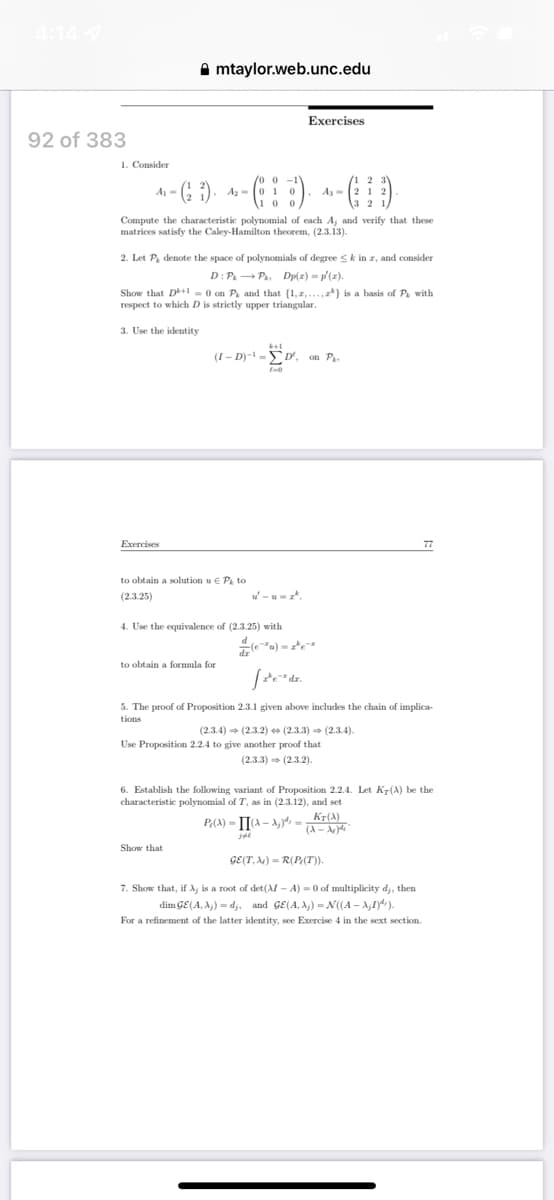2. Let P, denote the space of polynomials of degreek in z, and consider D: P P. Dp(x) -p'(x). Show that D1-0 on P, and that (1,2,...) is a basis of P, with respect to which D is strictly upper triangular.
2. Let P, denote the space of polynomials of degreek in z, and consider D: P P. Dp(x) -p'(x). Show that D1-0 on P, and that (1,2,...) is a basis of P, with respect to which D is strictly upper triangular.
Elements Of Modern Algebra
8th Edition
ISBN:9781285463230
Author:Gilbert, Linda, Jimmie
Publisher:Gilbert, Linda, Jimmie
Chapter8: Polynomials
Section8.4: Zeros Of A Polynomial
Problem 22E
Related questions
Question
#2

Transcribed Image Text:92 of 383
1. Consider
/0 0
4- (121). A₂01
mtaylor.web.unc.edu
Exercises
(9)
0
32
Compute the characteristic polynomial of each A, and verify that these
matrices satisfy the Caley-Hamilton theorem, (2.3.13).
2. Let P, denote the space of polynomials of degree ≤k in z, and consider
D: PPk Dp(z) = p'(x).
Show that D²+1 = 0 on P, and that {1,2,...,} is a basis of P, with
respect to which D is strictly upper triangular.
3. Use the identity
to obtain a solution u € P to
(2.3.25)
to obtain a formula for
Exercises
(I-D)-¹-D, on P
4. Use the equivalence of (2.3.25) with
A₂-
-u-z
Show that
[zez dz.
5. The proof of Proposition 2.3.1 given above includes the chain of implica-
tions
(2.3.4)→ (2.3.2) ↔ (2.3.3) → (2.3.4).
+
Use Proposition 2.2.4 to give another proof that
(2.3.3) (2.3.2).
→
6. Establish the following variant of Proposition 2.2.4. Let K(A) be the
characteristic polynomial of T, as in (2.3.12), and set
P(A) - II(A-A₂)²(A-Aede
Κτ(λ)
344
77
GE(T) = R(P(T)).
7. Show that, if X, is a root of det (AI-A) = 0 of multiplicity dj, then
dim GE (A, Aj) = d., and GE(A, X) = N((A-X,1)).
For a refinement of the latter identity, see Exercise 4 in the sext section.
Expert Solution
This question has been solved!
Explore an expertly crafted, step-by-step solution for a thorough understanding of key concepts.
Step by step
Solved in 3 steps

Recommended textbooks for you

Elements Of Modern Algebra
Algebra
ISBN:
9781285463230
Author:
Gilbert, Linda, Jimmie
Publisher:
Cengage Learning,


Algebra & Trigonometry with Analytic Geometry
Algebra
ISBN:
9781133382119
Author:
Swokowski
Publisher:
Cengage

Elements Of Modern Algebra
Algebra
ISBN:
9781285463230
Author:
Gilbert, Linda, Jimmie
Publisher:
Cengage Learning,


Algebra & Trigonometry with Analytic Geometry
Algebra
ISBN:
9781133382119
Author:
Swokowski
Publisher:
Cengage